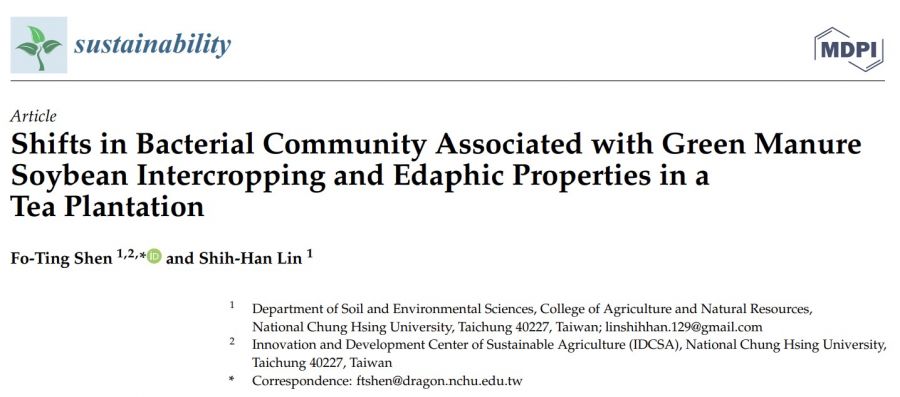循環農業:農業有機廢棄物生物處理再利用【土壤環境科學系/沈佛亭教授】
| 論文篇名 | 英文:Shifts in bacterial community associated with green manure treatment and edaphic properties in a tea plantation 中文:茶園間作綠肥大豆對根圈細菌群落與土壤性質的影響 |
| 期刊名稱 | SUSTAINABILITY |
| 發表年份,卷數,起迄頁數 | 2021, 13, 11478 |
| 作者 | Shen, Fo-Ting(沈佛亭)*; Lin, Shih-Han |
| DOI | 10.3390/su132011478 |
| 中文摘要 | 於慣行栽培茶園探討間作綠肥大豆對根圈細菌群落與土壤性質之影響。研究結果顯示種植綠肥大豆一個月至九個月均可提高細菌群落之功能多樣性、族群多樣性與六大類碳源的代謝潛勢,其中細菌群落結構由原本優勢的寡營養菌門(Acidobacteria, Chloroflexi, WPS-2)逐漸轉變為富營養菌門(Bacteroidetes, Proteobacteria)。種植綠肥大豆後可提高具有機物質分解和/或植物生長促進潛力菌科Burkholderiaceae, Chitinophagaceae, Sphingobacteriaceae與Sphingomonadaceae的相對豐富度,亦具有提高土壤肥力與改良退化土壤之效果。 |
| 英文摘要 | The continuous cultivation with excessive application of agrochemicals has led to the deterioration of soils. Incorporating leguminous green manure (GM) was found to improve the physicochemical and biological properties of soils. However, the influence of GM soybean intercropping on the temporal distribution of bacterial communities in strongly acidic soils is less explored. In this study, a nine-month field trial of soybean intercropping was conducted in a deteriorated tea plantation. This was used to test the hypothesis that GM treatment ameliorates tea-cultivated environments through changing bacterial communities as well as edaphic properties. GM treatment was demonstrated to increase both functional and population diversity during all the months that were considered. An alteration of life strategies exhibited by bacterial communities in GM treatment was observed, which shifted from oligotrophy (Acidobacteria, Chloroflexi, and the candidate phylum WPS-2) to copiotrophy (Bacteroidetes and Proteobacteria). This also contributed to the remarkable increase in metabolic potential of bacterial communities toward all six carbon source categories. The potentially versatile organic matter decomposers and/or plant growth-promoting bacteria, such as Burkholderiaceae, Chitinophagaceae, Sphingobacteriaceae, and Sphingomonadaceae bacteria, were identified as the most effective biomarkers in GM treatment. These bacterial groups showed strong correlation with soil pH; organic matter; and available K, Ca, and Mg. The increased diversity, metabolic potential, and copiotrophic taxa provided insight into the benefits brought by soybean intercropping, with enhanced community stability, facilitated nutrient cycling, and microbe–plant interactions in the strongly acidic tea plantation. |
| 發表成果與本中心研究主題相關性 | 本研究旨在探討綠肥大豆間作對茶樹行間細菌群落結構之影響,進而評估種植綠肥大豆提高茶園土壤細菌多樣性與有益菌群之潛力,研究成果有助於茶園土壤之健康管理與永續發展。 |







